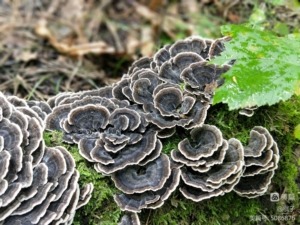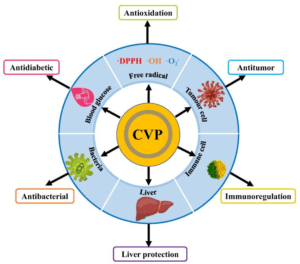Coriolus Versicolor (CV), also known as Turkey Tail, is a kind of folk medicine and edible fungus growing on tree trunks. The main components of CV are proteins, fats, polysaccharides, polysaccharide peptides, glucans, amino acids, and a variety of inorganic salts.
Coriolus Versicolor polysaccharide (CVP) is one of the important bioactive substances in CV. It has a variety of pharmacological activities, including antioxidation, antitumor, immune regulation, liver protection, repair of cerebral ischemia-reperfusion injury, and anti-diabetes. As a macromolecular polysaccharide, CVP has a complex spatial structure, and its biological activities are often closely related to its structure. Generally, it mainly includes molecular weight, monosaccharide type, and polysaccharide conformation. To promote the product development and clinical application of CVP, we systematically reviewed the biological and physiological activities of CVP. We preliminarily discussed its structure-activity relationship to provide a reference for developing and utilizing polysaccharide drugs and health products.
- Antioxidation
Under normal circumstances, the human body will produce a certain amount of free radicals to regulate cell growth and inhibit viruses and bacteria. However, excessive production of free radicals can also lead to various types of illness, such as arteriosclerosis, Alzheimer′s disease, and cardiovascular and cerebrovascular diseases. Polysaccharides can prevent and treat these diseases as antioxidants by breaking the peroxide chain reaction. Numerous studies have shown that polysaccharides can scavenge free reactive oxygen species. Their groups can combine with hydroxyl radicals or superoxide anion radicals to form water to eliminate free radicals. As an active component of polysaccharide categories, CVP also has good antioxidant activity and is an excellent biological antioxidant with broad development prospects.
 Many studies have found that the monosaccharide composition (glucuronic acid, galactose, and glucose) and molecular weight greatly impacted the antioxidant activity of polysaccharides in vitro. The content of glucuronic acid (GlcA) in acidic polysaccharides was positively correlated with its antioxidant activity, and the higher the content of GlcA, the better the antioxidant activity. In neutral polysaccharides, the higher the content of glucose, the better the antioxidant activity. The smaller the molecular weight, the more dispersed the state, which is conducive to the combination with oxygen free radicals, and the stronger the antioxidant activity.
Many studies have found that the monosaccharide composition (glucuronic acid, galactose, and glucose) and molecular weight greatly impacted the antioxidant activity of polysaccharides in vitro. The content of glucuronic acid (GlcA) in acidic polysaccharides was positively correlated with its antioxidant activity, and the higher the content of GlcA, the better the antioxidant activity. In neutral polysaccharides, the higher the content of glucose, the better the antioxidant activity. The smaller the molecular weight, the more dispersed the state, which is conducive to the combination with oxygen free radicals, and the stronger the antioxidant activity.
The monosaccharide composition of CVP included Man, Glc, Gal, and Fuc, and the relative molar ratio was 2.71:63.80:3.53:1.18. And the molecular weight was 1.61 kDa and 41.7 kDa. It can be seen that CVP contains a lot of Glc and has a small molecular weight, so it is speculated that CVP has good antioxidant activity. CVPS-3 exhibited higher DPPH radical scavenging activity (64.9% at 0.8 mg/mL), superoxide radical scavenging activity (78.4% at 1.2 mg/mL), and hydroxyl radical scavenging activity (71.2% at 2.0 mg/mL), which is slightly less than about 90% of Vc at the same concentration, showing certain antioxidant activity. Another study measured the ability of CVP to scavenge the 1,1-diphenyl-2-picrylhydrazyl (DPPH) radical, 2,2′-azino-bis (3-ethylbenzothiazoline-6-sulfonic acid) (ABTS) radical, and OH radical. The results showed that at 0.8 mg/mL, 0.6 mg/mL, and 7.0 mg/mL, CVP had the maximum scavenging rates of the three free radicals, which were about 85%.
In contrast, ascorbic acid (Vc) had a scavenging capacity of about 95% at the same concentration. The scavenging capacity of CVP was close to that of Vc, showing a slightly stronger antioxidant activity. The above two results showed that CVP had good antioxidant activity, which confirmed the above speculation. The total fermentation products of CV and their polysaccharides have obvious scavenging ability against the superoxide anion radical (O2•−) and hydroxyl (OH) radical.
The results showed that at 5 mg/mL, the scavenging rates of CVP for two kinds of free radicals were 60% and 81%, respectively, which is slightly less than 95% of Vc at the same concentration, showing a more vigorous antioxidant activity. At the same time, the antioxidant activity of CVP might be closely related to CV’s type, origin, and growth environment. CVP has a different DPPH radical scavenging capacity in different regions. The results showed that the scavenging capacity of CVP against the DPPH radical in Heilongjiang was the best, and the IC50 was 0.832 g/mL. The results showed that the scavenging rates of the O2•− and OH radicals of the wild varieties at the maximum concentration were 53% and 72%, respectively, which were significantly higher than those of the cultivated varieties (p < 0.05).
Some previous antioxidant experiments in vivo have explored the antioxidant effect of CVP on rat brains and its mechanism. The results showed that CVP could increase the activity of superoxide dismutase (SOD) and glutathione peroxidase (GSH-Px), as well as reduce the content of malondialdehyde (MDA), promoted free radical scavenging, and have an obvious antioxidant effect. After CVP participated in the treatment, the expression levels of the two enzymes increased, and the oxidation level in the brain decreased, indicating that CVP had good antioxidant activity in vivo. In the antioxidant experiment in mice, researchers found that the glycopeptide of CV (PSK) could reduce the oxidative damage of oxidized low-density lipoprotein (Ox-LDL) to macrophages, improve the SOD activity of mouse peritoneal macrophages, and increase the content of manganese superoxide dismutase (MnSOD) mRNA.
As an excellent antioxidant, Vc has a strong free radical scavenging ability, up to about 95%. Although the scavenging capacity of CVP is mainly 60–90%, slightly lower than that of Vc, it also shows that CVP has strong antioxidant activity, which may be attributed to its relatively high Glc content and small molecular weight, which is consistent with the structure-activity relationship analysis. The results of the antioxidant experiment in vitro show that CVP has good scavenging activity against the DPPH radical, OH radical, and ABTS radical. The results of the antioxidant experiment in vivo showed that CVP could increase the activity of SOD, GSH-PX, and CAT, reduce the content of MDA, accelerate the elimination of free radicals, and have an obvious antioxidant effect. At present, the antioxidant research of CVP mainly focuses on in vitro experiments. However, the research on the effect and mechanism of antioxidants in vivo is still insufficient, so it is necessary to strengthen the research in this field.
- Antitumor Activity
Cancer, also known as a malignant tumor, is a disease caused by abnormal cell growth and proliferation mechanisms. It has become a significant threat to human life and health. Chemotherapy and antitumor drugs are commonly used at present, but they also show severe side effects. Therefore, it is very important to find new anticancer alternative medicines. Many studies have reported that natural polysaccharides have shown good anticancer activity in in vitro and in vivo animal studies, with less toxic side effects, providing a new direction for cancer treatment. Therefore, studying CVP’s antitumor activity and its mechanism is very important.
Most results showed that most polysaccharides with β-(1→3)-d-glucan as the main chain had antitumor activity. In addition to glucan, some exoglycans and galactans also show antitumor activities to varying degrees. In addition, it was found that some heteropolysaccharides also have antitumor activity. The branching degree of the molecular structure of plant polysaccharides is closely related to the antitumor activity. Different branching degrees show different biological activities. The above structural analysis results show that the main chain of CVP was composed of the (1→4)-β-/(1→3)-β-d-glucopyranosyl group, and its branches were attached to the O-6 site, with molecular weights of 1.61 kDa and 41.7 kDa, respectively, indicating that CVP had good antitumor potential. Some studies have shown that the antitumor mechanism of CVP might be related to the downregulation of the Bcl-2 and Fas gene expression in cells.
CVP could inhibit the proliferation and induce apoptosis of mouse B16 cells, and its mechanism might be related to downregulating the expression of P53, Bcl-2, and Fas genes in cells. At the same time, we also found that CVP could inhibit the growth and induce apoptosis of HeLa cells, and its mechanism was related to the downregulation of Bcl-2 gene expression. Regulating the release of immune factors was also an important mechanism of CVP’s antitumor activity. CVP could promote the proliferation of NK cells and release various immune factors through immune regulation to inhibit the proliferation of tumor cells and realize the apoptosis of tumor cells. The antitumor activity of CVP might be related to its molecular weight. The appropriate molecular weight was easier to combine with the receptors on the surface of tumor cells, thus affecting the proliferation of tumor cells.
A study found that CVPs-b with a molecular weight of 39,000 Da could inhibit the proliferation and apoptosis of esophageal carcinoma (ESCA) cells, regulate the cell cycle of ESCA cells, and induce more tumor cells to enter a quiescent state faster. CVP could also be combined with XELOX to treat advanced colorectal cancer, which can improve long-term efficacy and has clinical value. Previous studies showed that CVP also has antitumor and anti-metastatic effects on mouse breast cancer 4T1 cells and 4T1 tumor mice. All the above results showed that CVP had a certain antitumor activity, proving the correctness of the above speculation.
Polysaccharide peptide (PSP) was also cytotoxic to HL-60 cells, and its mechanism was speculated to induce apoptosis through the upregulation of early transcription factors such as AP-1 and EGR1. PSP could inhibit the proliferation and induce apoptosis of HL-60 and U-937 cells and destroy the G1/s and G2/M phases of the cell cycle, indicating that PSP had a good antitumor effect. Meanwhile, PSP could inhibit cell proliferation, inhibit the progress of cells in the S phase and G2 phase, reduce the uptake of 3H thymidine in HL-60 cells, and prolong the time of DNA synthesis to inhibit tumor growth.
The above studies show that CVP has good antitumor activity related to its main chain and the appropriate molecular weight, which are conducive to its binding with cell sites and play a role in health. On the one hand, CVP directly acts on tumor cells, affects the s and G2 phases of the cell cycle of tumor cells, upregulates the early transcription factors, induces apoptosis or inhibits oncogene expression, and directly kills tumors. On the other hand, it can enhance the body’s immune ability by acting on the inflammatory factor pathway CXCL12/CXCR4 and promoting the growth of NK cells to kill tumor cells. Therefore, CVP has less-toxic side effects and a good antitumor effect. It is expected to become a new antitumor drug. However, the detailed mechanism of CVP killing tumor cells is unclear, and further research is needed.
- Immunoregulation Activity
Disease prevention and treatment is the most important goal to enhance the body′s resistance through exercise and therapies related to improving immunity. The vast majority of polysaccharides have immunomodulatory effects, and various pharmacological actions of polysaccharides seem related to their immunomodulatory actions. This may be because polysaccharides are one of the immune system′s primary targets. T lymphocytes, B lymphocytes, natural killer cells, and macrophages are important immune cells that play a crucial role in the immune system through cellular immunity. As a natural polysaccharide, CVP also has the function of immune regulation. It can be used as an immune regulator or biological response regulator.
The low toxicity, high molecular weight, branching structure, and conformation of polysaccharides may be important for the host’s immune system to produce appropriate responses. In different types of polysaccharides, β-d-glucan is considered to be the most important immunomodulatory polysaccharide. β-d-glucan is a repeating structure of the d-glucose unit, expressed by β-glycosidic bonds.
So far, several straights and branched chains with great biological activity potential have been reported for β-d-glucan. According to the previous analysis of CVP structure, the main chain of CVP is composed of the (1→4)-β-/(1→3)-β-d-glucopyranosyl group, and glucose has the highest content of monosaccharides, indicating that it has good immunomodulatory potential. CVP could improve neural function in a rat cerebral ischemia-reperfusion injury (Ciri) model through immune regulation. The mechanism is related to inhibiting the activation of the p38MAPK signaling pathway. CVP could also significantly induce the upregulation of CD80, CD86, and MHCII molecules expressed by bone marrow-derived dendritic cells and stimulate BMDC cells to release IL-6, IL-12p40, and TFN-α to realize immune regulation. These results showed that CVP had certain immunomodulatory activity, which proved the correctness of the above speculation. CVP could restore the number of leukocytes and improve the level of antibody, TNF-α, and IFN-γ, reduce the phagocytic activity and nitric oxide (NO) level, and prevent the overexpression of proinflammatory cytokines.
Therefore, CVP can be used as an effective compound to regulate the immune response. At the same time, the synthesis of NO and related enzymes was closely related to the immunomodulatory activity of CVP was mediated by Syk mediated the phagocytosis activated by CVP- and CK2-dependent signaling pathways and also confirmed that CVP stimulates phagocytosis by activating endothelial nitric oxide synthase (eNOS), inducible nitric oxide synthase (iNOS), and TNF-Dectin-1 signaling pathways, which helps to clarify the mechanism of glucan-induced phagocytosis. CVP could also restore the spleen and thymus index, enhance the proliferation of T cells and B cells, and phagocytosis of peritoneal macrophages in immunosuppressive mice induced by cyclophosphamide. In a study, CVP might improve immune function by enhancing the proliferative activity of immune cells, inducing immune cells to produce NO, and regulating or promoting the secretion of cytokines.
 Similarly, previous studies also showed that Coriolus Versicolor β-Glucan (CVG) increased the expression of SR-B1 by activating the CK2 pathway and Dectin-1 signal. The phagocytic activity of CVG was stronger than that of microorganisms and algae. In in vivo antitumor experiments in mice, the researchers found that after CVP stimulation, the phosphorylation levels of ERK-1/2 and p38MAPK increased significantly in a time-dependent manner. CVP could use the cell membrane Ig and TLR-4 as potential immune receptors to activate mouse B cells through the MAPK and NF-κB signaling pathways. In future research, researchers can have a more in-depth discussion.
Similarly, previous studies also showed that Coriolus Versicolor β-Glucan (CVG) increased the expression of SR-B1 by activating the CK2 pathway and Dectin-1 signal. The phagocytic activity of CVG was stronger than that of microorganisms and algae. In in vivo antitumor experiments in mice, the researchers found that after CVP stimulation, the phosphorylation levels of ERK-1/2 and p38MAPK increased significantly in a time-dependent manner. CVP could use the cell membrane Ig and TLR-4 as potential immune receptors to activate mouse B cells through the MAPK and NF-κB signaling pathways. In future research, researchers can have a more in-depth discussion.
These results show that CVP has good immunoregulatory activity, which is related to its (1→4)-β-/(1→3)-β-d-glucopyranosyl groups, and a high content of glucan is closely related. On the one hand, the immunomodulatory activity of CVP depends on the role of NK cells, B cells, T cells, and macrophages. On the other hand, it regulates the number of leukocytes, interleukin, TNF-α, IFN-γ, and other cytokines and stimulates the TLR4, MAPKs to NF-κB, and other pathways. It can be seen that CVP is a polysaccharide with multiple immunomodulatory functions, which is expected to be developed into a new immunomodulator. Still, its specific regulatory mechanism and safety need to be further investigated.
- Other Benefits
Besides the above physiological activities, CVP also plays an important role in protecting the liver, antibacterial effects, cerebral ischemia-reperfusion, and treatment of diabetes. We studied the hepatoprotective effect of CVP by establishing the NIAAA alcohol injury mouse model. The study found that CVP could significantly reduce the levels of alanine aminotransferase (ALT), aspartate aminotransferase (AST), total cholesterol (TC), glutamine transaminase (TG), and other enzymes and increase the level of high-density lipoprotein, which played a role in protecting the liver. In another study, CVP was stable at room temperature, had antibacterial action against both Gram-positive and Gram-negative bacteria, and had a broad spectrum of antibacterial action. It was speculated that the polysaccharide macromolecule had good surface activity, which could promote the dissolution of the outer wall of harmful bacteria and destroy their survival and reproduction.
At the same time, CVP also could improve the behavioral ability of Ciri rats, reduce the volume of cerebral infarction, inhibit neuronal apoptosis, and have a good protective effect on nerve injury after cerebral ischemia-reperfusion. The CV extract with a polysaccharide content of 17.74% (CV/W) could significantly reduce cardiac fibrosis in diabetic rats and inhibit transforming growth factor β1(TGF-β1)/Smad signal transduction. It could also significantly reduce cardiac inflammation in diabetes rats, significantly improving cardiac dysfunction.

Leave A Comment